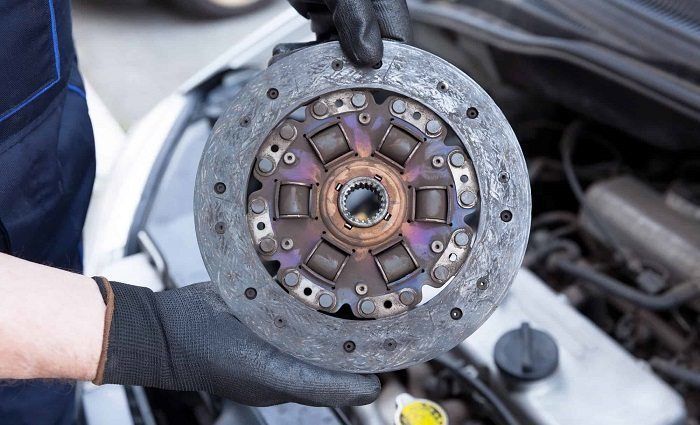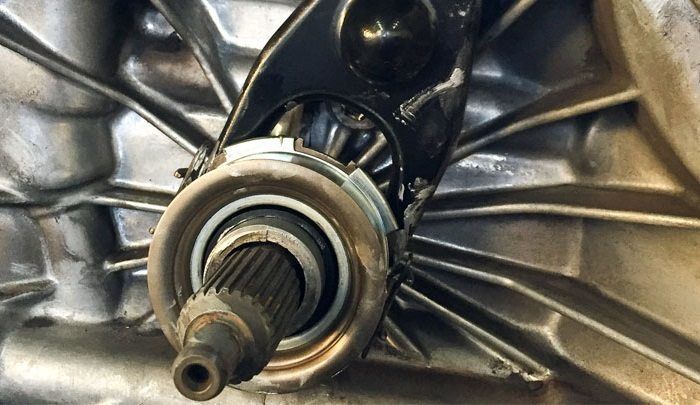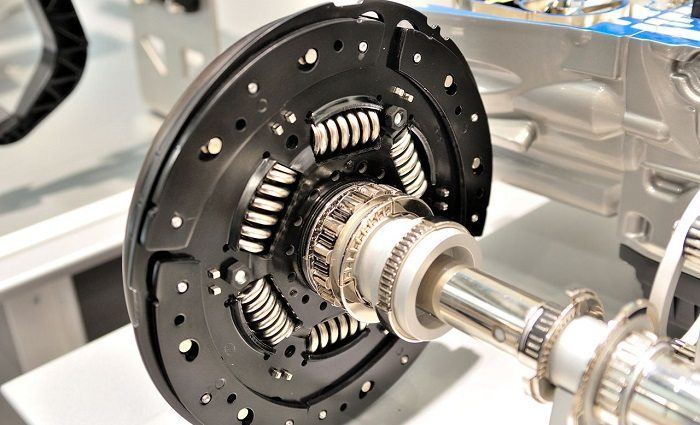by Joshua Thomas
A clutch plays a vital role when it comes to changing gears in a manual transmission system, and it will consist of several components that work together for smooth gear shifting which include the throw-out bearing.
The throw-out bearing helps with the clutch depression. Hence, in case it fails, you might not be able to depress the clutch, and so you will not be able to change gears.
Because this bearing is only used when depressing the clutch, it is not always easy to tell when it is faulty. Here we aim to change things by explaining some of the main symptoms of a throw-out bearing failure.
Contents

Before diving into the symptoms of a throw-out bearing failure, it is worth making it clear what the throw-out bearing is.
Throw-out bearing is one of the four main components of a transmission system with the others being the flywheel, clutch plate, and pressure plate.
This bearing makes gear shifting smooth and seamless by helping to disengage the transmission from the vehicle's engine. And it ultimately controls the amount of contact between the flywheel and clutch plate, which are the other vital elements in a transmission system.

Like with any other vehicle problem, the symptoms of a throw-out bearing failure will vary from one situation to the other and even between different vehicle makes and models. But, for most manual transmission systems, the following are some of the most common symptoms of a failing throw-out bearing.
The first symptom that you will typically notice just when the throw-out bearing is starting to fail is some odd or strange noises when you depress the clutch.
In many instances, the noise will be a rattling or grinding sound as you depress the clutch, and its intensity will depend on the extent of the damage.
But as concerning as these noises might be, it is also important to note that in many cases they can point to other issues with the clutch assembly or even the transmission. Hence you need a keen ear to tell whether it is the throw-out bearing, but a professional diagnosis will even be more accurate.
An easy way to tell that the noise is from the throw-out bearing is that it will be most noticeable when you have the clutch fully depressed and go away when you release it. Also, the noise will appear to be coming from the vehicle’s transmission area.
How the clutch feels when depressing is another easy way to tell when you have a throw-out bearing failure.
If the problem is at a more advanced stage, the clutch performance will be compromised, and it will feel stiff or at least less smooth when you press it down.
The more the throw-out bearing wears out or fails, the harder it will become to press down the clutch pedal. And as the problem progresses, it might get to a point where it will be impossible to disengage the clutch, which makes it difficult to drive your vehicle.
A vibrating clutch pedal is another good indication that the throw-out bearing is failing and you need to check and fix it.
When this bearing is in good working condition, your clutch should move down steadily and smoothly, but when you start noticing some vibration coming from the pedal, this is an indication there is an issue with the throw-out bearing.
These vibrations will in many instances come from the failing throw-out bearing being unable to lineup well with the pressure plate on the transmission system. As they happen, your foot should feel some pulsations, and these vibrations are more like what brake pedals feel when you have unevenly worn-out brake pads.
Because you need the clutch to change gears in your manual transmission vehicle, failure in any part of the clutch assembly including the throw-out bearing will often make it hard to shift the gears.
If you notice any difficulties when changing gears such as it not being smooth enough or the gears grinding when shifting, this can be an indication that you have a bad throw-out bearing.
A clutch pedal that does not engage fully or is difficult to press down as a result of a throw-out bearing failure often also causes issues when shifting gears. But, this is often not the first symptom and will only come up as the problem worsens.
If you fail to notice all the symptoms above or like a huge chunk of motorists you ignore them, this fifth symptom, which is a total clutch failure, is hard to miss or ignore as you will not be able to drive the vehicle.
Total clutch failure is an expensive issue to repair and will also take more time and skill to fix, meaning you have to take your vehicle to the auto repair shop.
Because the clutch system relies on different components to work, a complete failure of one such as the throw-out bearing will render the clutch unusable. Hence, before you get to this point, it is important not to overlook the symptoms above and fix the bearing as soon as possible.

While in some instances the throw-out bearing failure is beyond your control, and there is nothing you can do, the good news is that it is still possible to minimize the likelihood of it occurring. Here are some handy tips you can use to ensure this.
One of the surest ways to prevent a throw-out bearing failure is to inspect your clutch assembly and the entire transmission system regularly and have any issues fixed by a professional mechanic immediately.
Through ongoing inspections, it will be easy to detect a throw-out bearing failure. In the early stages, the problem is quick, easy and cheap to fix. Also, inspections can allow you to anticipate any possible clutch issues as you can closely monitor how the parts wear out.
Following a precise maintenance routine is also a good way to prevent this common issue. And this is because you can have your clutch and the rest of the transmission well-serviced and on time.
By ensuring you do not overuse your clutch, you can, in turn, extend the lifespan of the bearings significantly as they will not have to work when they do not have to.
Also, try to minimize the time you have the clutch pedal depressed. The longer the clutch is depressed the more pressure and abuse the throw-out bearing is subjected to, and hence the higher the likelihood of failing.
A good example of this is when you have to stop at a red light. Instead of keeping the clutch depressed, you should shift the gear to neutral and then take your foot off the clutch pedal and only engage it again when you want to move.
Manual transmission vehicles are not as common as they were a few decades ago as the modern automatic transmission ones have taken over almost completely.
Hence, it is understandable that many motorists tend to have difficulties with manual transmission vehicle and in the process, many will develop bad driving habits.
Changing some of these bad or poor driving habits such as always having one foot on the clutch when driving or unnecessary start and stops can help keep your throw-out bearing and other clutch components in good working condition for long.
Note: While the throw-out bearing is a simple and inexpensive clutch assembly part, it can still be quite expensive to replace give the high labor cost since the job is quite labor-intensive as the entire transmission system has to be removed. Hence, it will be wiser to try and prolong its lifespan by changing your driving habits and through regular inspection and maintenance.
While a throw-out bearing might be just a small and simple part that almost looks insignificant, it will play a crucial role in your clutch assembly and hence your transmission system.
Most will typically last for ages, and many motorists hardly ever have to worry about it. However, it is still important to know the symptoms to watch out for to know when yours is failing to ensure more timely intervention which is often cheaper.
With this in mind, it is also a good idea to take measures to prevent throw-out bearing failure as this will not only save you money but also keep your vehicle running smoothly. Preventing the problem is also often much easier than dealing with it.
Sources
 |
 |
 |
 |

About Joshua Thomas
Joshua Thomas just simply loves cars and willing to work on them whenever there's chance... sometimes for free.
He started CarCareTotal back in 2017 from the advices of total strangers who witnessed his amazing skills in car repairs here and there.
His goal with this creation is to help car owners better learn how to maintain and repair their cars; as such, the site would cover alot of areas: troubleshooting, product recommendations, tips & tricks.
Joshua received Bachelor of Science in Mechanical Engineering at San Diego State University.
Just Car Care